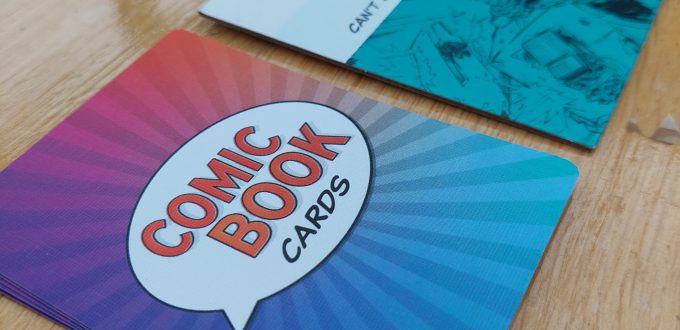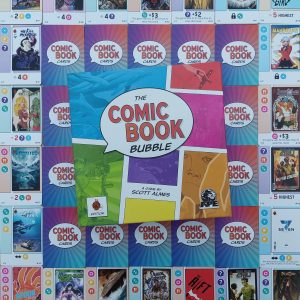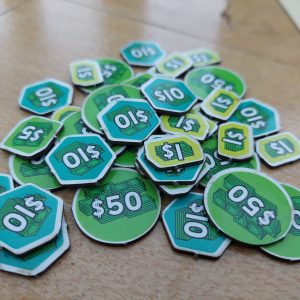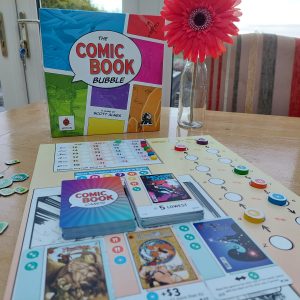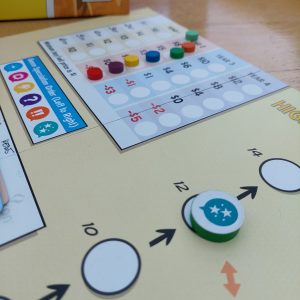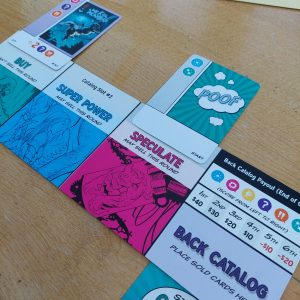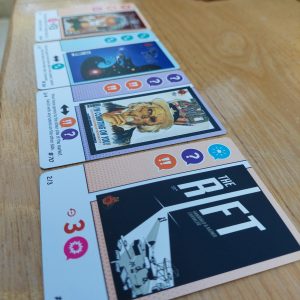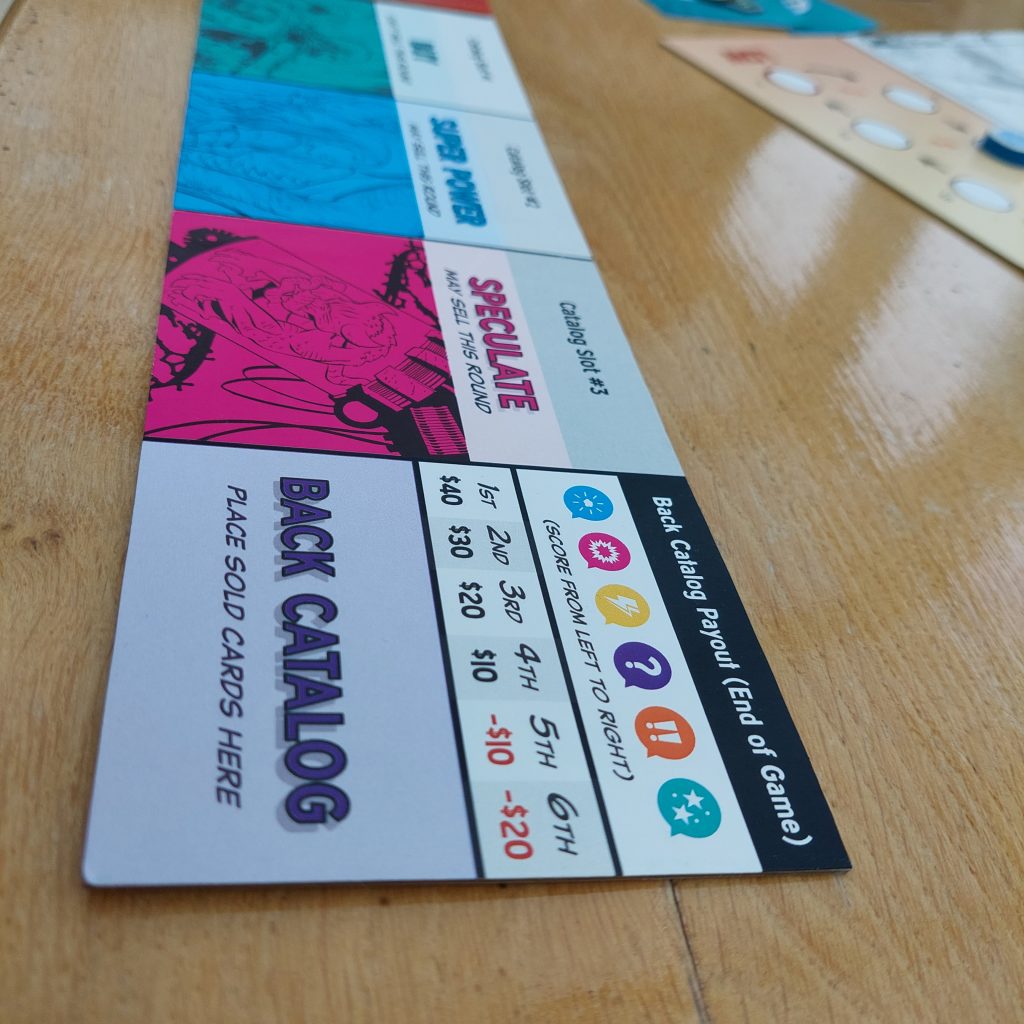Economic speculation has never been more fun in the super thematic market manipulation game, The Comic Book Bubble, by APE Games!
Publisher: APE Games
Designer: Scott Almes
Solo Designer: Scott Almes
Artist: N/A
IP Collaborator: Red 5 Comics
Release date: 2023 (Kickstarter launch date TBC)
1-5 Players
Age: 10+
30 – 35 mins
*Speculation * Economic * Strategic * End Game Bonuses * Close Drafting (Pick and Pass) * Solo Mode * Push Your Luck * Action Selection *Hand Management * Simultaneous Action * Fun * Surprise *
Great Scott!
Scott Almes is one clever guy. I didn’t realise how many superb Scott Almes games I had in my collection until I started to notice teeth gnashing and hair pulling coinciding with his name appearing on my table. So to be asked to preview Comic Book Bubble was an absolute no-brainer!
Before we get too graphic, however, I need to clarify that I have only played a prototype of The Comic Book Bubble. This means that the game and game play I describe could be different to the finished product once the campaign ends and production begins.
For those who don’t know, Kickstarter is a crowd-funding platform used to get an idea from paper to people. And when it relates to board games, it becomes a promise to make and deliver a game based on the ideas the designer is offering if enough money can be raised. As The Comic Book Bubble works and feels buttoned-up, I’m hoping nothing major is going to change in terms of the rules between now and then. But never say never! And sometimes inspiration KAPOWs a designer after a campaign smashes its target. So, just to be clear, everything I say is based on the prototype copy I have played. Cool? Okay, let’s get going!

Comic-Econ!
So what is The Comic Book Bubble all about? Well, it’s about comics of course. More specifically those published by Red 5 Comics (Mandrake, etc). But The Comic Book Bubble is actually about trading them rather than reading them. Buying comics when the price is low and selling them when their value hits the top of the market. Basically making moolah before the bubble bursts and their worth drop like a stone again!
The Comic Book Bubble is therefore an economic game. But what it has that many don’t is a very cool theme and a very clever, very easy to operate speculation mechanism.

Set em’ up, Spook!
The setup is simple. The main “Genre” board shows the prices that 6 different genres of comics will be worth on any given turn and in any given year.
Played over 4 years, each year the end price of the previous year is the starting cost for the next. The Genre board shows the market itself where those prices go up and down, as well as spaces for the deck, discarded cards, and speculation (including the order in which the genre speculate when that action is taken).
Individual Player boards act as your active catalogue (where you can store up to 3 comics), back catalogue (where you store sold comics) and action spaces.
First turn, you’ll have a choice of 2 starting comics that go straight into your active catalogue as well as $20 in your purchasing fund. Then before each year begins, everyone gets 5 comic cards from the deck.
On your turn you choose just 1 to keep (before eventually passing the rest on to the next player). Once everyone has selected their card, you simultaneously reveal the action you are going to take by placing your comic card face up on the relevant slot on your player board.
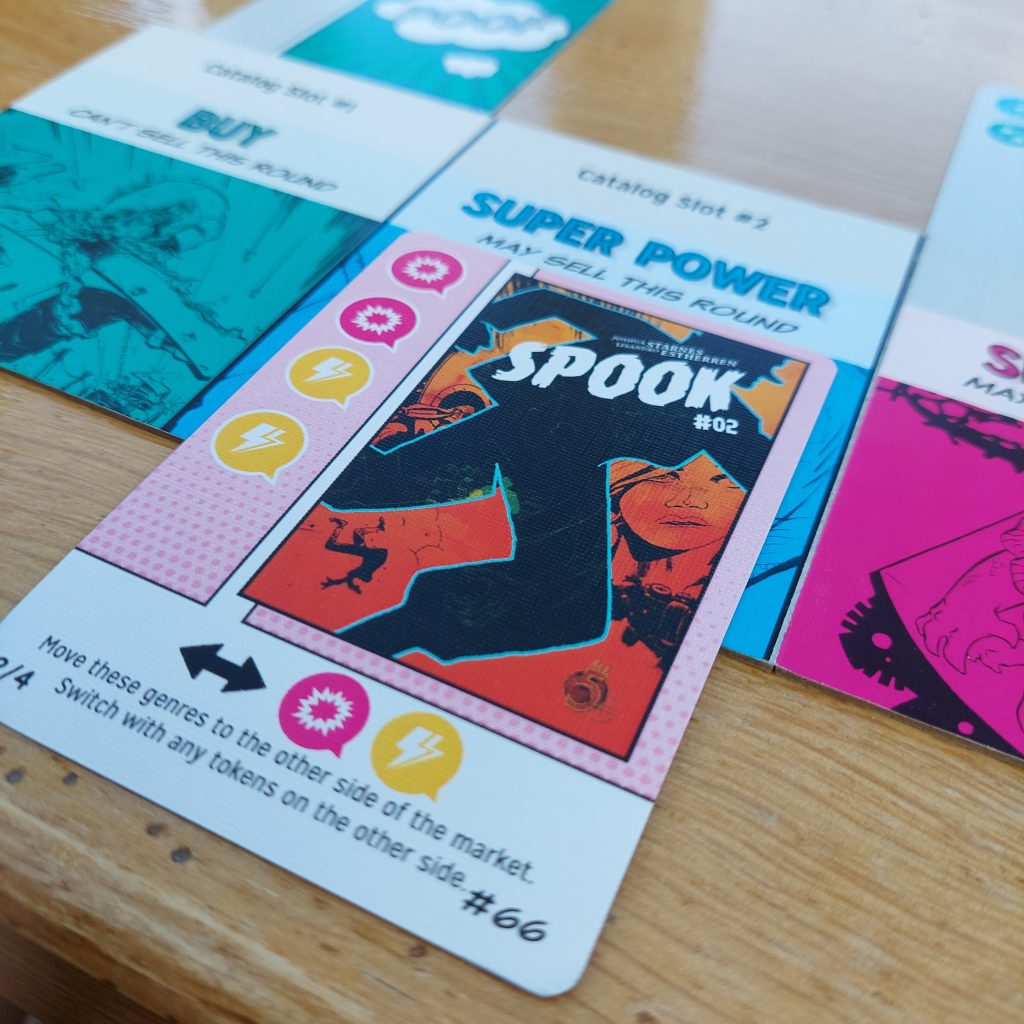
You choose 1 of 3 actions:
- Buy – this means you pay for the comic you have just laid down and then you place it in your active catalogue. The price you pay is the combined cost of the genre symbols on it, and the cost of each genre is shown in the relevant Year you’re playing. You can never pay less than $1 even if the total is -$.
- Super Power – this means you do the action shown on the card you just laid. It could be manipulating the market tokens a specific way, selling an extra comic or some other action that you wouldn’t otherwise be able to do on your turn. If more than one player chooses this action then they are resolved in number order (each card has a catalogue # on it).
- Speculate – this is where you start manipulating the market prices and changing up what the comics in your active catalogue (and hands – not that you know what’s coming next!) are worth. The mechanism is easy; everyone who speculates lays their card on the space on the board. If fewer than 3 choose this action, another card is added from the deck. Then the number of each genre type on display gets totalled – going in the specified genre order shown on the board. Then each large genre token moves clockwise around the market those number of spaces. Note that tokens skip over others so only empty slots count as moves. Then when all the visible genres have been moved, the small markers under the Year column are moved around to match. As a result, some or all of the genres are now worth a completely different amount! Once done, the speculated cards are discarded.
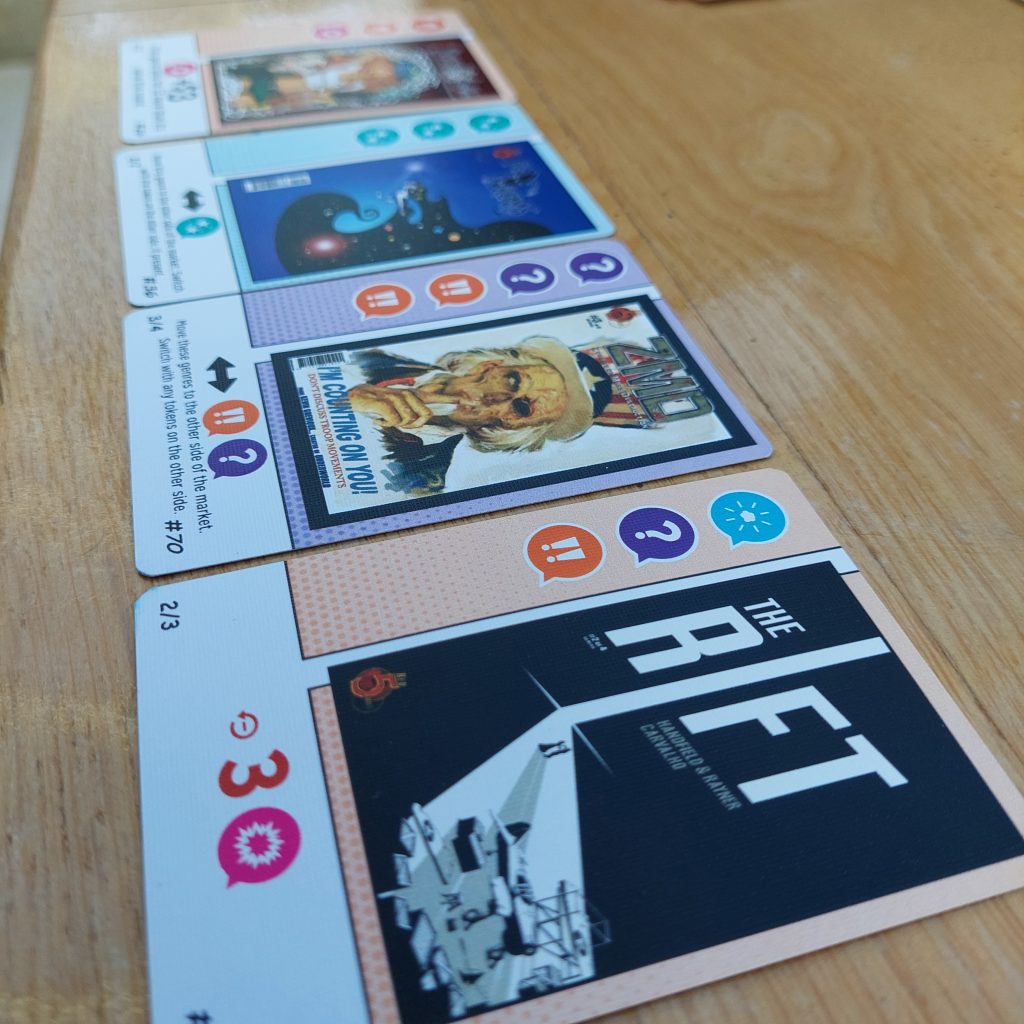
Now, if you choose to use either a Super Power or Speculate, you can also do a bonus “Sell” action once Speculation has ended. This means you can sell a comic from your active catalogue and this is tucked under your board face down into your back catalogue.
Just like Buying, the price you receive is the combined value of the genres shown on your card, and the price for each is shown in the relevant Year you’re playing in. So if you have just used a Super Power or Speculated, and the market manipulation has skyrocketed some genres shown on your catalogue cards, you can (and should!) cash in by selling one whilst it is at the top! Once again, you can never sell for less that $1 (and you’d think that you wouldn’t want to but remember you only have 3 slots to store potential cash cow comics!).
Once everyone has done what they’re doing that turn, your cards are passed to the next player and a new turn begins. The Year ends when everybody only has one card left – it still gets passed but forms the first card of the next Year’s starting hand so don’t play it. The small Year genre markers get shifted across to become the next year’s opening prices and everyone gets 4 more cards to make a new starting hand of 5.
When the 4th Year ends, the game is over and final scoring takes place. Everyone reveals the cards in their back catalogue and counts up the number of each genre they have in total. Then players receive bonuses or penalties for having the most of each genre. These are then added or deducted from players’ money piles before revealing the amount each player has made overall. Whoever has played the market like a maestro wins!

What goes up……..
We are loving this game! With starting comics already in your catalogue ready to sell, your engine in The Comic Book Bubble is already revving. And that momentum brings pace to the game from the first turn which is excellent.
Not only that, but the speculation market value switcheroo is the most frustratingly fun mechanism I have played in some time! Watching your catalogue comic values go from top to bottom and not being able to do anything about it is mortifying in the best possible way! Having pushed-your luck collecting specific genres and see their prices change in the way you don’t want them to is nail biting.
Setting your sights on a sweet Super Power – Sell combo only to find your genres tanking at the end of other players’ Speculation phase is teeth gnashingly bad. But again these feelings are experienced in the BEST POSSIBLE WAY!
It means your strategies have to flip-reverse each turn to counter the market volatility. And as a result it feels bang on theme! I feel like I am trying to ride the economic rollercoaster to buy low and sell high. Just watching those tokens shimmy up and down the board, switching sides – it’s like I’m Bobby Axelrod from Billions watching my values plummet and sky rocket!

Speculate to Accumulate
Not being able to buy and sell in the same turn is clever. If you bought when your matching genres were low and then other players’ Super Powers or Speculations ramped up the value, you’d instantly profit from their actions in the Selling phase. But because you can’t, you have to implement a strategy that will try to keep the genres you’re gunning for at the top of the market for at least one more turn!
Don’t get me wrong; low prices can be good. If you want to buy, being at the bottom is great. Picking up a genre generous card for $1 is a coup! But if you want to sell or need to make space in your active catalogue for something better, you might need to take a hit and offload even when the market is against you. That dilemma is sometimes AP inducing but for us that means the game is working exactly as it should. It is making us think…hard!
As you would expect, Speculation is the biggest unknown in any turn. If you join in, you know how many of each genre you are bringing to the market party. But you don’t know what anybody else has up their sleeve. And that could mean the gentle genre nudge up the circuit you had in mind turns into a hop, skip and a jump back down to rock bottom! I have lost track of how many times I slap my forehead and pound the table with my fists in every game. And that is a VERY.GOOD.SIGN.
I appreciate that some players may not like this sense of being out of control. Setting up a turn and then seeing its worth wiped out can be disappointing. But for us, that is the essence of this game. It is what happens when trading in the real world and in games where push-your-luck is a big element. You make a play and external forces do a number on you. And we find this exciting and frustrating and addictive. It makes us more determined to try and play smarter next turn and next year. If you go into a game knowing it is a speculating, market manipulating, financial free-for-all, then hopefully you’re there because that is exactly what you want to play!
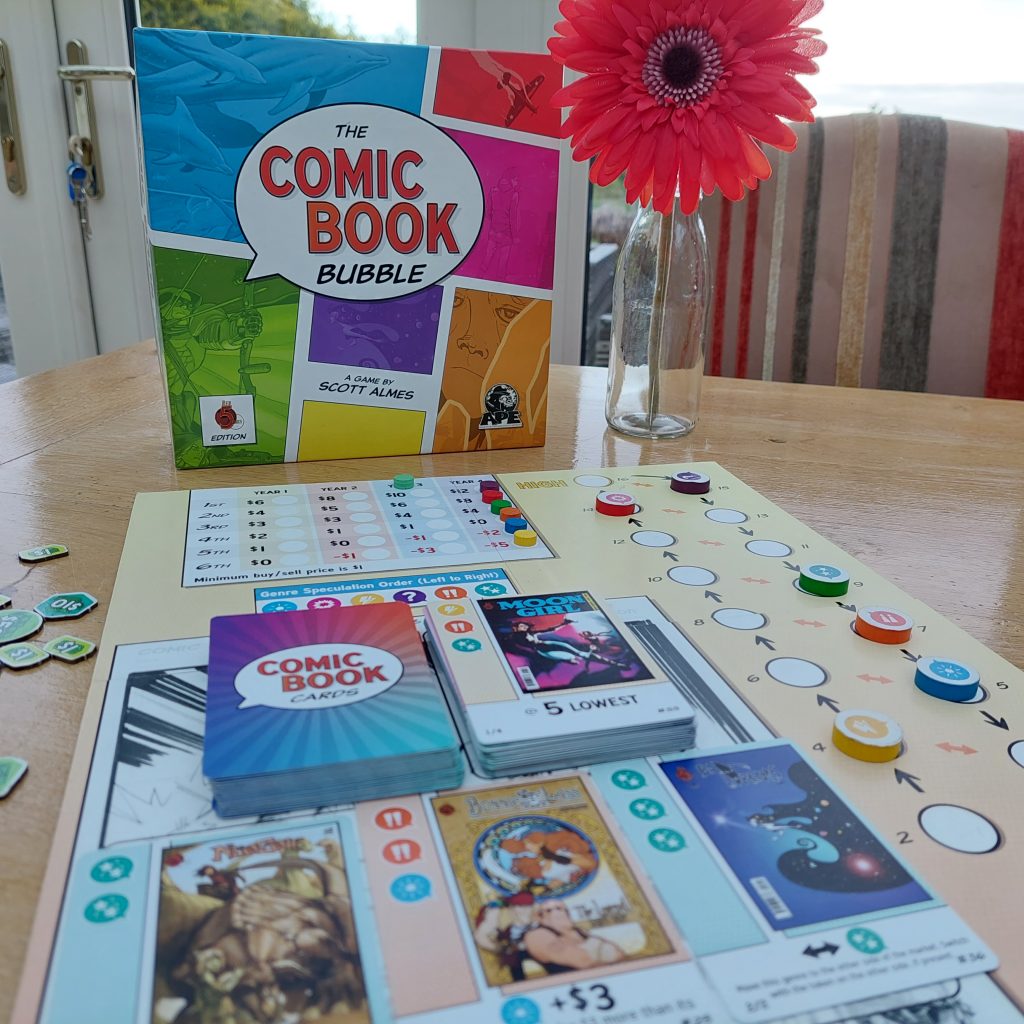
I mentioned “surprise” as a headliner because at the end of the game there are bonuses for majority genres in your back catalogue. Now, I was absolutely tanking in a game the other day. Everything I tried to sell was rolling around the bottom of the market and everything I wanted to buy was going to cost the earth. But, when it came to end scoring, I made up some serious ground. And this was based on what I had collected over the course of the game. It wouldn’t really have helped me to remember what I was collecting as the value is not determined at the end. But it turned out that I had collected a bunch of matching genres that, when assessed against the back catalogue payout, gave me a cash injection. It was a sort of unexpected catch up mechanism. Now, it won’t always be like that. In fact, based on final market positions, you may end up losing even more money if your most popular genres happen to be down the hole, so don’t rely on it. But it was a sweet moment when it turned out like that!
Market Madness!
This game plays great at 2. We didn’t know whether it would feel a little articifical at the lowest count given the close drafting element. But, like It’s a Wonderful World and Isle of Cats the pick and pass between two works really well! Knowing that your only opponent is going to take a card you leave and do something with it that directly benefits them (and likely hurts your chances to win!) ramps up the pressure to make every decision count. Every move feels personal! Adding an extra card into speculation also helps increase the randomness needed to recreate the market movements of larger player count games.
And the extra chaos at 3+ is fantastic! So much market moving, price changing, and all round manipulation each turn is eye wateringly exciting! Because some elements of the game are simultaneous, however, adding players doesn’t add much to the game length. Yes, there are more opportunities for downtime if players get struck down by analysis paralysis in the comic selecting phase. But the excitement of each round and the volatile nature of the game encouraged people to push their luck that little bit more in the 4 and 5 player games we tried. I haven’t tried the solo mode yet, but I can’t wait to see how well it mimics the game play at higher counts.
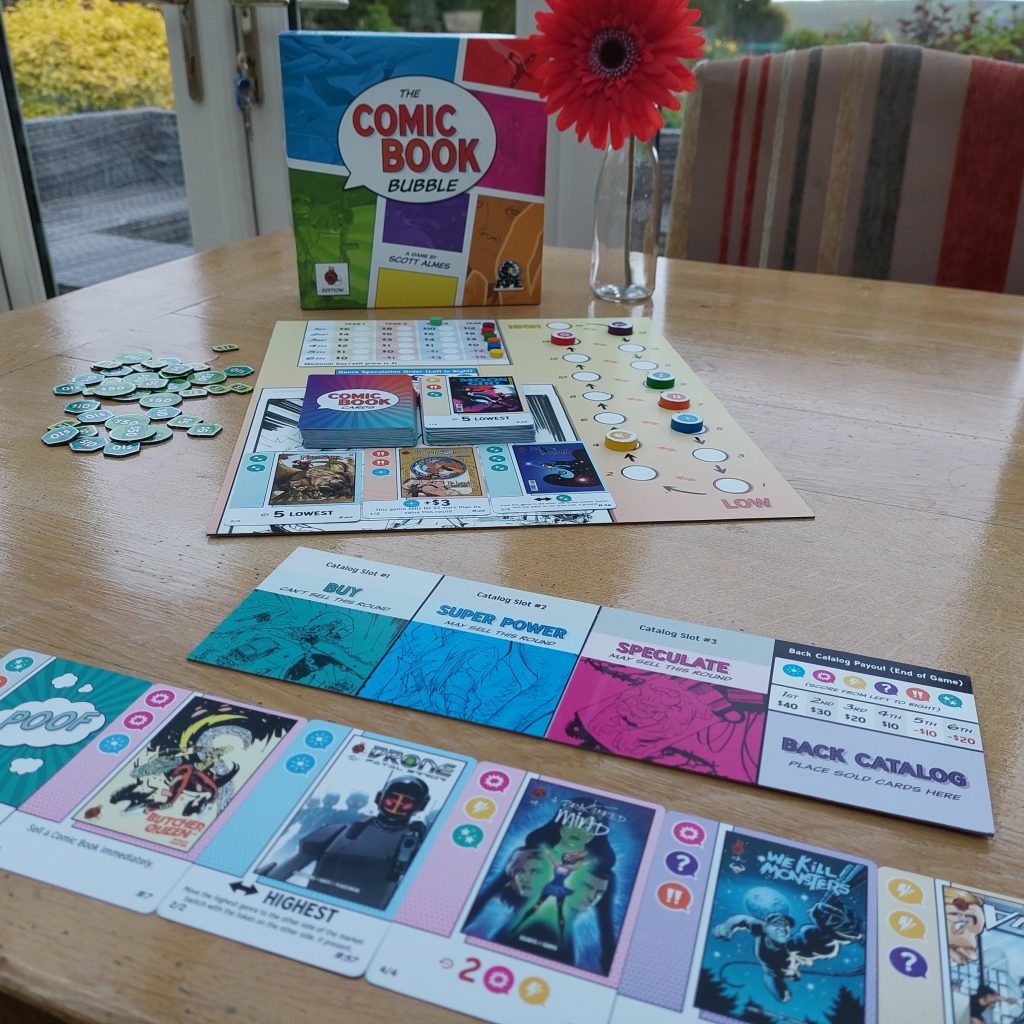
Graphic!
The Comic Book Bubble features real comic covers from Red 5 Comics. I don’t know if the choices are set in stone yet or whether there will be changes during production. I only mention it now as some of the covers in the prototype we played show women and men portrayed quite differently as well as featuring some difficult/unexpected themes. I won’t say more for now as I have given feedback to the publisher on this, and I am hopeful that it will be addressed before the final game is in production. If any of the photographs in this review have included images which are upsetting, however, please let me know.
The general artwork on the components in the prototype is great and really fits with the comic setting – plenty of KAPOWs and BOOMs and atmospheric art! I can’t comment on the final quality as I don’t know what that will be like. In terms of the gameplay, it feels like a really well thought out game, so I am hoping the rules don’t change much between now and fulfilment.
I do wonder whether it in fact needs a Year marker as the genre price tokens show which Year is in effect (especially as it got muddled up with the other mini price markers on a few occasions when we played). I also wonder whether the final board will have small recesses for each year price marker, although being able to slide them about also helps with super speedy switch arounds! These are mere minor musings though, and so it will be interesting to see how the finished game looks and feels!
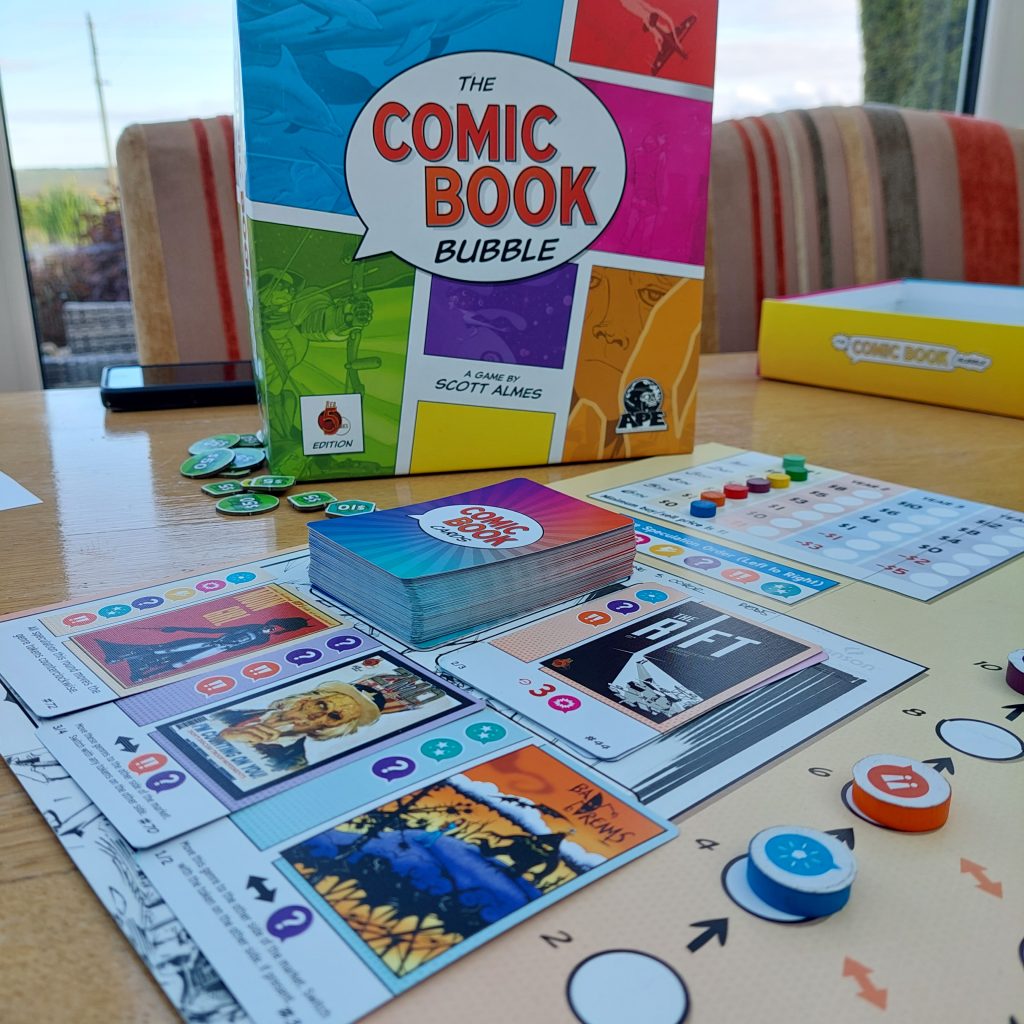
Bubble Aint Burst!
We have really enjoyed playing The Comic Book Bubble. In fact, we will be really sad to see it go which is the best possible sign! I am hopeful that our enthusiasm acts as an indicator of how successful the campaign will be for Scott and APE Games.
For a game listed as an economic speculation game, I was worried that Scott might have gone rogue and designed something a little bit long. Dare I say it, a little bit dry for our tastes. But The Comic Book Bubble has been neither of those things for us. Having to strategise against external market forces and mitigate changes on the hop is fast, furious, frustrating fun! I should never have doubted you, Scott!
I want another Year every time we have played, and I’m bouncing up and down when the market starts moving! The base mechanism is very simple, but it works really well. It’s definitely an easy to learn, hard to master game, and we always shoot those kinds of games right to the top of our list.
And I get that The Comic Book Bubble could be based on any theme – the market manipulation mechanism being applicable to every commodity. But I like the link back to the 80s comic book bubble and the pop art colours are cool! Trading corn cobs or crystals would work equally well. But the superhero based theme is a hit in our house where we are all Marvel mad!
If this preview and our initial thoughts on The Comic Book Bubble gameplay has fired up your interest, it is going to be launching on Kickstarter soon! (When the campaign page goes live, this will be updated and shared on my social media accounts!)

